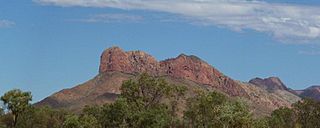Ngoia Pollard Napaltjarri facts for kids
Quick facts for kids
Ngoia Pollard Napaltjarri
|
|
|---|---|
| Born | c.1948 Haasts Bluff, Northern Territory, Australia
|
| Nationality | Australian |
| Known for | Painting |
|
Notable work
|
Swamps west of Nyirripi |
| Awards | painting prize, 2006 National Aboriginal & Torres Strait Islander Art Award |
Ngoia Pollard Napaltjarri (born around 1948) is an Indigenous artist from Australia. She speaks the Walpiri language and comes from the Western Desert area. Ngoia Pollard married Jack Tjampitjinpa, who was also an artist. They had five children together.
Ngoia Pollard started painting in 1997. She won a big art prize in 2004. Later, in 2006, she won the painting prize at the National Aboriginal & Torres Strait Islander Art Awards. Her artworks are now in important collections. These include the National Gallery of Australia.
Contents
Ngoia Pollard's Early Life
Ngoia Pollard was born around 1948. Her parents were Angoona Nangala and Jim Tjungurrayi. She was born in Haasts Bluff, Northern Territory, which is west of Alice Springs. The exact year of her birth is not always clear. This is because many Indigenous Australians measure time differently. They often remember dates by comparing them to other big events.
Ngoia Pollard has a special name called 'Napaltjarri'. This is a 'skin name'. Skin names are part of a system used by central Australian Indigenous people. These names show how people are related to each other. They also help decide who can marry whom. Skin names are not like last names in European cultures. So, 'Ngoia Pollard' is the part of her name that is truly her own.
Ngoia Pollard went to school in Papunya, Northern Territory. She also worked in the mission kitchen there. She married Jack Tjampitjinpa. They moved to Kintore, Northern Territory, and then to Mount Liebig. This place is now called Amundurrngu Outstation. It was empty when they moved there. Mount Liebig is about 50 kilometres west of Haasts Bluff. It was one of many small communities started by people from Papunya in the 1970s. Ngoia Pollard and Jack had five children. Jack passed away in 1988. As of 2008, Ngoia was still living at Mount Liebig.
Discovering Art
How Western Desert Art Began
Modern Indigenous art in the Western Desert started in 1971. Indigenous men in Papunya began painting. A teacher named Geoffrey Bardon helped them. They used acrylic paints to create designs. These designs often looked like body paintings or ground sculptures. This new art style quickly spread across central Australia. A government art program started in 1983, helping it grow even more. By the 1980s and 1990s, this art was shown all over the world.
At first, only men were the artists. This included all the people who started the Papunya Tula art company. Some men in central Australia did not want women to paint.
Women Join the Art Movement
However, many women wanted to paint too. In the 1990s, a large number of women started creating artworks. In Western Desert communities like Kintore, Yuendumu, and Balgo, people began making art specifically to sell and show.
Ngoia Pollard's Artistic Journey
Ngoia Pollard started her art career by helping her husband. He painted with Papunya Tula artists for several years before he passed away. In 1997, Ngoia Pollard began painting on her own. In 2004, she won first prize in a painting competition. This competition was supported by the Centralian Advocate newspaper.
In 2006, Ngoia Pollard won the painting prize at the National Aboriginal & Torres Strait Islander Art Awards. Her winning artwork was called Swamps west of Nyirripi. Another painting she made that year, with the same title, was bought by the Art Gallery of South Australia. Also in 2006, she spent time in Copenhagen, Denmark, as an artist-in-residence. She shared this experience with another Indigenous artist, Lilly Kelly Napangardi. They had known each other since they went to school together in the 1960s.
Her artworks are held in important places, like the National Gallery of Australia. She has also had her own art shows in galleries in Sydney and Perth.
Themes in Ngoia Pollard's Art
Western Desert artists like Ngoia Pollard often paint special stories called 'dreamings'. These are stories for which they have a personal connection or rights. Many of Ngoia's paintings are about the area of Yamunturrngu, or Mount Liebig. This is her father's traditional land.
Her art is often about the spiritual power of the watersnake. This snake lives in the swamps and lakes near Nyirripi. This area is considered 'dangerous territory' northwest of Mount Liebig. Her paintings often look very calm, with many small dots. But they actually show the dangers of the land and its creatures.
Ngoia's artworks often use oval shapes. These shapes represent swamps and lakes. She usually paints with black and white colors. Sometimes she uses red to make the oval shapes stand out. The dotted patterns in her paintings show the ground cracking as water dries up. She also paints about the sand hills of the desert.
Collections
- National Gallery of Australia
- Corrigan Collection


